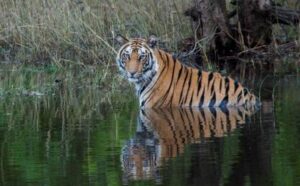Traveling can be an overwhelming experience for some people in India and getting to the rural heartland of the country which is mostly covered with wilderness is even more daunting. In this day and age, most national parks offer safari tours that are very safe, accessible and vary from affordable to luxurious. But before going for tiger safari in India, we have listed some of the important questions you should ask yourself first –
Where to Go for Tiger Safari in India?
Spotting tigers is a matter of luck and jeep safaris in India can help you increase your chance to spot a tiger. Some national parks in India are well known for their dry deciduous forests to spot tigers and they have great number of jeeps that visit the park. Here are some of the best national parks for tiger sightings –
- Bandhavgarh National Park
- Kanha National Park
- Pench National Park
- Panna National Park
- Ranthambore National Park
Which is the best season in India for tiger spotting?
A lot of national parks in India remain closed during monsoon for tourists from July to September and remain open the rest of the year. The scenario varies by season and national parks in India and you can enjoy them in different ways –
- The jungle looks more beautiful than ever with dense greens in October and November with pleasant temperatures.
- Witness the golden light through the morning mist during the picturesque winters of India from December to February when the temperature falls to around 0 degrees. So, be sure to carry layers of warm clothes.
- March to June remains the dry summers in India where you can find the most number of tigers spending their time across several water bodies in the wilderness. They usually get there to quench their thirst and wait for their prey discretely like monkeys and deer. You can also spot the tigers in the water to beat the heat of summer.
How many days do I need to spare for tiger safari in India?
The national parks in India are usually located far off from the vast metropolitan cities. So, you need to take at least a few days to visit a national park. Ideally, you should take 8 to 10 safaris and spend 4 nights at least to improve your likelihood to spot a tiger and wildlife in India. You also need some time to understand the wilderness itself.
Despite the wilderness, there is no need to worry about accommodation as there are many budget hotels and lodges available from homestays and 3-star hotels to 5-star lodges for a great safari experience.
How many weeks or days before I need to plan for safari?
Because of limited safari permits available in India, you need to arrange for a safari permit at least four months before confirming the safari trip in India. There are many tour operators you can choose who can guide you regarding permits, accommodation, safari and other arrangements.
Is wildlife safari safe in India?
When it comes to going for a wildlife safari, safety is the no.1 concern. Hence, we have listed some of the tips to ensure a fun and safe safari experience on your stay –
Safari tips –
- It is vital to hire experienced drivers, guides and naturalists who can stay with you all the time and instruct you regarding the safety of the safari.
- You need to trust the guide and listen to them in any case of uncertainty.
- All the wildlife lodges provide their safety briefing when you check-in for accommodation and you need to keep that in mind.
- The forest guards stay in the check-posts and watch-posts in the forests that are available at short intervals. You can access them for any emergency.
- Animals are rarely the interruptions for safari jeeps as they prefer to keep out of any human interaction.
Tips for staying in lodges
- Some lodges have properly maintained the habitat of the jungle and they are located in the proximity to venomous and non-venomous snakes, leopards, tigers, wild boars, and elephants.
- So, it is advised to avoid wandering alone in the very early morning or at night and carry a torch or flashlight in the dark.
- Also, keep all the doors and windows closed to avoid the entry of any insect or reptiles in your room at dusk.
- Carry all the food items in your room and store them in a cool place.
What types of vehicles are available for safari?
Generally, park management allows only 4×4 open-air jeeps for jungle safari for providing the best viewing experience. These vehicles can go deep into the jungle and have a seating capacity of 6 passengers along with driver and guide. Be sure to book exclusive or private safari to have a better experience without sharing with anyone.
What documents are needed for safari?
It is advised to carry all your original identification documents for each safari –
- Passports are mandatory for foreign tourists.
- Aadhar Card, Passports, Voter ID, and Driving License are required for Indian tourists.
Food and Water – The lodges allow light breakfast and water to carry along which you can have at a specific spot in the park. Be sure to confirm your booking with your agent or lodge.
Will I have a Cellular or Wi-Fi network?
You may get Wi-Fi in some resorts but the chances are very rare to get the proper signals in the wilderness and rural areas. The Wi-Fi network is also slow in most resorts. You can just send emails or messages over WhatsApp. In case of any emergency requirements, the lodge staff may help you.
How about the safari timings?
Basically, the jungle safari is available in two-time slots in India –
- Morning Safari – From early morning till 11:00 hrs
- Afternoon safari – From 3 PM till evening.
Safari timings also vary as per the seasons.
Winter – Safaris start a bit later than in summer as per the sunrise and end a bit earlier by the evening as the sun sets earlier in winter and days are usually shorter.
Summer – Since the days are longer, safaris start earlier in the morning and later in the afternoon because days are hotter too.
You can also opt for a photographer’s permit, a special permit for full-day safari. You can stay the whole day inside the park from morning till evening.








